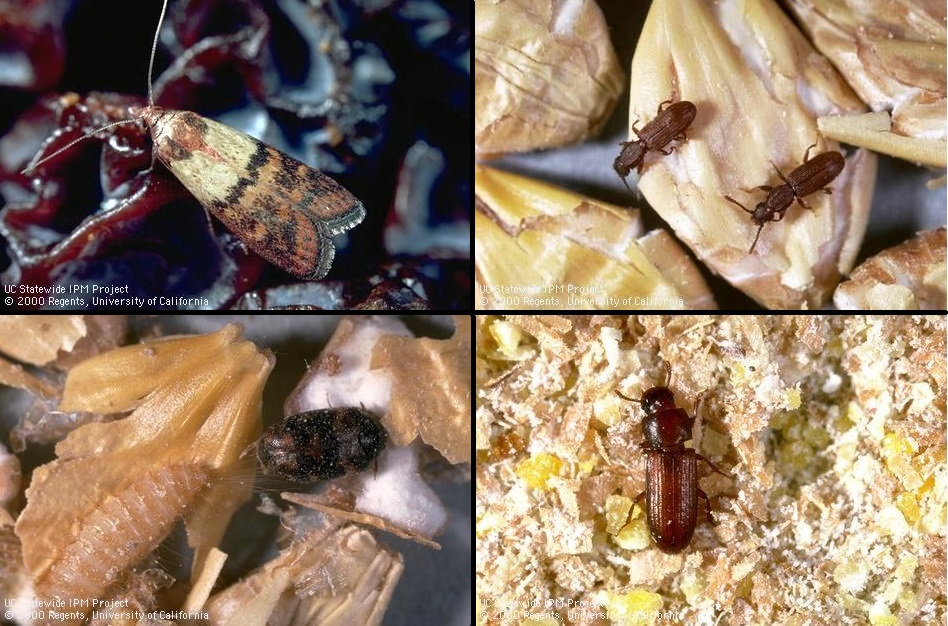 Stored Product Pests - April 22, 2020 Jeff Schalau, Agent, Agriculture & Natural Resources University of Arizona Cooperative Extension, Yavapai County Insect pests of stored products have probably impacted each of us from time to time. Maybe you’ve seen a small moth fluttering after you grabbed an oatmeal carton from the cupboard or measured a cup of flour and noticed small specks or webbing in it. Stored product pests typically infest food and nonfood products of plant and animal origin. Due to their intermittent appearance and secretive habits, stored product pests may not be immediately apparent. The term “stored product pest” usually does not include kitchen ants, but does include a few small moths and beetles. The life cycle of stored product pests, moths and beetles, includes an egg stage, several larval stages, a pupal stage and the adult stage. Adults often mate soon after emergence and then immediately begin searching for a food source. During their lifetime, females lay approximately 100 to 1,000 eggs, depending upon the species. After deposition, eggs incubate for days to weeks. Following egg hatch, larvae develop while infesting and consuming their food resource, remaining mostly unseen. Larval stages are called “instars”. Each successive instar is larger in size and consumes greater amounts of food than the previous instar. Larval development requires weeks to a month or more to complete. The last larval instar pupates, and an adult emerges a short time later. Under optimum conditions, such as warm temperatures and high humidity, most stored product pests can complete a life cycle in just four to five weeks. There are usually multiple generations per year. In some species of stored product pests, only the larval stages consume food. In these cases, the sole purpose of the adult insect is to mate, discover a food resource, and deposit its eggs during the short period the insect remains alive. Insect species in which the adults also feed can be long-lived, survive and continue to infest and feed on susceptible foods for several months to a year. Indianmeal moths (Plodia interpunctella) are the most common stored product pest in homes, where it may infest bird seed, breakfast cereal, and other consumables. Indianmeal moths are most commonly found infesting food items in kitchen cupboards, but adults may be found throughout the home because they are excellent fliers and readily disperse from the food item they are infesting. Adults may be found away from the larval food source. Their wings are bicolored and alternate between beige and copper. Moths are most active at dusk, when they can be seen indoors flying while searching for mates and food. During the day, moths can be found resting motionless on walls and ceilings, often near their larval food source. Adults are short-lived and do not feed. Sawtoothed grain beetles (Oryzaephilus surinamensis) are nearly as common as the Indianmeal moth, and infest many of the same foods (especially bird seed, breakfast cereals, chocolate, and dried fruits and nuts). Adults are small (approximately 1/16 to 1/8 inch long) and flat. They can be identified, aided by use of a hand lens or magnifying glass, by the row of pointed teeth located on each side of the thorax (middle body section), just behind the head. Red flour beetles (Tribolium castaneum) are 1/8 to 3/16-inch-long, flattened, and dark cherry to dark brown in color with gradually-clubbed antennae. These long-lived beetles are serious pests of grain processing facilities and food warehouses, but can also be found in grocery stores and home cupboards. Flour beetles cannot eat whole, intact kernels of grain. The grain must be damaged or milled (i.e., flour). To stop a current infestation of a stored product pest, the source of the insects must be found and eliminated. The infestation can be stopped by finding and removing the insect’s food sources, vacuuming (or removing) food crumbs from hard-to-reach locations in the cupboard. To find insect-infested material, inspect all items listed previously as susceptible to infestation, begin with those potential sources closest to where most of the adult insects are found. To prevent infestations, food should be stored in tightly sealed containers or in a refrigerator or freezer. Monitor “use by” dates and consume older packages before newly purchased foods. Dry pet food and bird seed, should also be stored in tightly sealed containers. There are many additional stored product pests and much more to know about them. More information is linked below. You can follow the Backyard Gardener on Twitter – use the link on the BYG website. If you have other gardening questions, email the Master Gardener Help Desk in Prescott (prescottmg@gmail.com) or Camp Verde (verdevalleymg@gmail.com) and be sure to include your name, location, and phone number. Find past Backyard Gardener columns or provide feedback at the Backyard Gardener web site: http://cals.arizona.edu/yavapai/anr/hort/byg/. Images  Stored product pests: Indianmeal moth (Plodia interpunctella, upper left); sawtoothed grain beetles (Oryzaephilus surinamensis, upper right); red flour beetle (Tribolium castaneum, lower right); and warehouse beetle (Trogoderma sp., lower left). Photos are by Jack Kelly Clark, University of California Statewide Integrated Pest Management.
Stored product pests: Indianmeal moth (Plodia interpunctella, upper left); sawtoothed grain beetles (Oryzaephilus surinamensis, upper right); red flour beetle (Tribolium castaneum, lower right); and warehouse beetle (Trogoderma sp., lower left). Photos are by Jack Kelly Clark, University of California Statewide Integrated Pest Management.Additional Resources Pantry Pests, University of California Agriculture and Natural Resources, Statewide Integrated Pest Management ipm.ucanr.edu/PMG/PESTNOTES/pn7452.html Indian Meal Moth, Colorado State University Extension extension.colostate.edu/topic-areas/insects/indian-meal-moth-5-598/ Dermestid Beetles (Carpet Beetles), Colorado State University Extension extension.colostate.edu/topic-areas/insects/carpet-beetles-5-549/ Grain Beetles, Utah State University Extension utahpests.usu.edu/schoolipm/structural-pest-id-guide/grain-beetles |